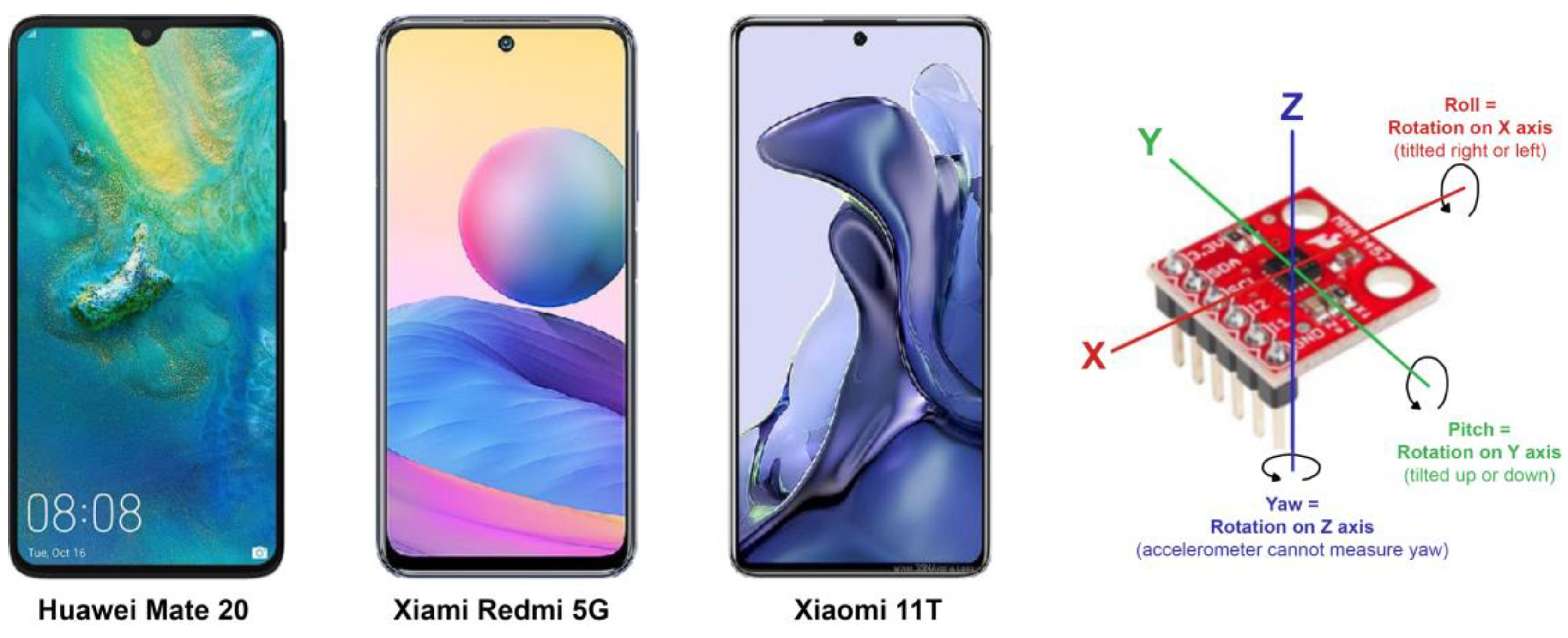Smartphone Sensors in Motion: Advancing Traffic Safety with Mobile Technology
Abstract
1. Introduction
- In educational and training settings, smartphones can be utilized for a variety of purposes, including teaching traffic safety and the physics of vehicle movement. Students can gain practical experience in the principles of deceleration measurement without the need for expensive specialized equipment.
- In the initial stages of research, where the need for extreme accuracy is not paramount, smartphones can serve as a cost-effective data collection tool. This enables researchers to rapidly collect and analyze data before resorting to more sophisticated and costly equipment.
- In the event of a traffic accident or other emergency, smartphones can provide immediate data on vehicle deceleration, which can be useful for analysis and decision-making before the arrival of professional teams and equipment (e.g., experts in road transport).
2. Materials and Methods
2.1. Measuring Equipment
2.1.1. Decelerometer
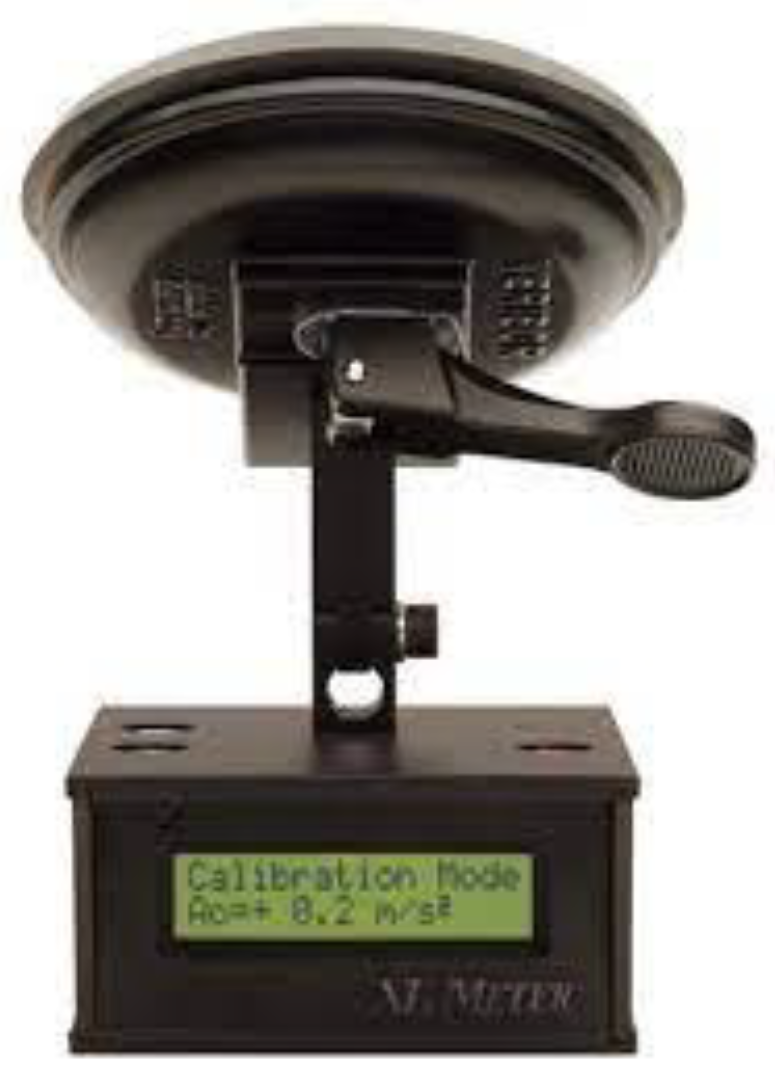
2.1.2. Smartphones
- -
- sensor speed—fastest;
- -
- sensor units—meters;
- -
- writing setting—number separator—space.
2.2. Vehicle
2.3. Measurement Location
2.4. Temperature of Brakes
2.5. Procedure of Measurements
2.6. Measurement Evaluation Process
3. Results
3.1. Measurement Results for the Dry Road
3.2. Measurement Results for the Wet Road
3.3. Measurement Results for the Gravel Road
3.4. Evaluation of Braking Distance
3.4.1. Braking Distance on Dry Road
3.4.2. Braking Distance on the Wet Road
3.4.3. Braking Distance on Gravel Road
4. Discussion
5. Conclusions
Author Contributions
Funding
Institutional Review Board Statement
Informed Consent Statement
Data Availability Statement
Acknowledgments
Conflicts of Interest
References
- Kožuch, P.; Hujo, Ľ.; Muślewski, Ł.; Markiewicz-Patalon, M. Dynamic and Stationary Testing of Vehicle Braking Systems. Acta Technol. Agric. 2023, 26, 238–243. [Google Scholar] [CrossRef]
- Kashkanov, A.; Semenov, A.; Kashkanova, A.; Kryvinska, N.; Palchevskyi, O.; Baraban, S. Estimating the Effectiveness of Electric Vehicles Braking When Determining the Circumstances of a Traffic Accident. Sci. Rep. 2023, 13, 19916. [Google Scholar] [CrossRef] [PubMed]
- Kashkanov, A.A.; Rotshtein, A.P.; Kucheruk, V.Y.; Kashkanov, V.A. Tyre-Road Friction Coefficient: Estimation Adaptive System. Bull. Karaganda Univ. Phys. Ser. 2020, 98, 50–59. [Google Scholar] [CrossRef] [PubMed]
- Kuchar, P.; Janoško, I.; Holúbek, M.; Čedík, J.; Pexa, M. The Accuracy Assessment of Devices Used for Distance Measuring in Dynamic Vehicle Tests. Acta Technol. Agric. 2022, 25, 150–156. [Google Scholar] [CrossRef]
- Ondruš, J.; Hockicko, P. Braking Deceleration Measurement Using the Video Analysis of Motions by Sw Tracker. Transp. Telecommun. J. 2015, 16, 127–137. [Google Scholar] [CrossRef]
- Min, K.; Yeon, K.; Jo, Y.; Sim, G.; Sunwoo, M.; Han, M. Vehicle Deceleration Prediction Based on Deep Neural Network at Braking Conditions. Int. J. Automot. Technol. 2020, 21, 91–102. [Google Scholar] [CrossRef]
- Tang, T.; Anupam, K.; Kasbergen, C.; Scarpas, A. Study of Influence of Operating Parameters on Braking Distance. Transp. Res. Rec. 2017, 2641, 139–148. [Google Scholar] [CrossRef]
- Viderščak, D.; Schauperl, Z.; Ormuž, K.; Šolić, S.; Nikšić, M.; Milčić, D.; Ormuž, P. Influence of Brake Pad Properties to Braking Characteristics. Promet 2022, 34, 91–102. [Google Scholar] [CrossRef]
- Ivanov, Z.; Sitnik, L.; Dimitrov, R.; Wrobel, R.; Mihaylov, V.; Skobiej, K.; Ivanov, D.; Andrych-Zalewska, M. Investigation Of Braking Deceleration In Vehicle. In Proceedings of the 2022 8th International Conference on Energy Efficiency and Agricultural Engineering (EE&AE), Ruse, Bulgaria, 30 June–2 July 2022; pp. 1–4. [Google Scholar] [CrossRef]
- Bošković, B.; Stojanovic, N.; Grujic, I.; Babic, S. Experimental Investigation of the Influence of Deceleration on Brake Elements Temperature in Order to Improve Traffic Safety. Therm. Sci. 2023, 286. [Google Scholar] [CrossRef]
- Skrúcaný, T.; Synák, F.; Semanová, Š. Influence of the Braking System That Is Contrary to Legislation on Breaking Characteristics of Passenger Car. Transp. Tech. Technol. 2018, 14, 1–5. [Google Scholar] [CrossRef]
- Kudarauskas, N. Analysis of Emergency Braking of a Vehicle. Transport 2007, 22, 154–159. [Google Scholar] [CrossRef]
- Erfianto, B.; Rahmatsyah, A. Forensic Analysis of Braking Classification Based on Acceleration, Jerk, and Velocity Data. Kinet. Game Technol. Inf. Syst. Comput. Netw. Comput. Electron. Control 2021, 6, 211–220. [Google Scholar] [CrossRef]
- Skrucany, T.; Vrabel, J.; Kazimir, P. The Influence of the Cargo Weight and Its Position on the Braking Characteristics of Light Commercial Vehicles. Open Eng. 2020, 10, 154–165. [Google Scholar] [CrossRef]
- Marienka, P.; Frančák, M.; Jagelčák, J.; Synák, F. Comparison of Braking Characteristics of Solo Vehicle and Selected Types of Vehicle Combinations. Transp. Res. Procedia 2020, 44, 40–46. [Google Scholar] [CrossRef]
- Maurya, A.K.; Bokare, P.S. Study of Deceleration Behaviour of Different Vehicle Types. Int. J. Traffic Transp. Eng. 2012, 2, 253–270. [Google Scholar] [CrossRef]
- Li, W.L.; Cao, C.; Zhou, W.; Gao, L. Influences of Initial Braking Velocity and Passenger Capacity on Mean Fully Developed Deceleration. Appl. Mech. Mater. 2013, 281, 201–205. [Google Scholar] [CrossRef]
- Li, W.L.; Zhou, W.; Gao, L. Vehicle Braking Efficiency On-Line Monitoring and Evaluation with MFDD. Adv. Mater. Res. 2012, 605–607, 968–971. [Google Scholar] [CrossRef]
- González, L.P.; Sánchez, S.S.; Garcia-Guzman, J.; Boada, M.J.L.; Boada, B.L. Simultaneous Estimation of Vehicle Roll and Sideslip Angles through a Deep Learning Approach. Sensors 2020, 20, 3679. [Google Scholar] [CrossRef]
- Zhang, S.; Li, D.; Du, F.; Wang, T.; Liu, Y. Prediction of Vehicle Braking Deceleration Based on BP Neural Network. J. Phys. Conf. Ser. 2022, 2183, 012025. [Google Scholar] [CrossRef]
- Hwang, M.H.; Lee, G.S.; Kim, E.; Kim, H.W.; Yoon, S.; Talluri, T.; Cha, H.R. Regenerative Braking Control Strategy Based on AI Algorithm to Improve Driving Comfort of Autonomous Vehicles. Appl. Sci. 2023, 13, 946. [Google Scholar] [CrossRef]
- Zamzamzadeh, M.; Saifizul, A.; Ramli, R.; Soong, M.F. Dynamic Simulation of Brake Pedal Force Effect on Heavy Vehicle Braking Distance under Wet Road Conditions. Int. J. Automot. Mech. Eng. 2016, 13, 3555–3563. [Google Scholar] [CrossRef]
- Ackermann, C.; Beggiato, M.; Bluhm, L.-F.; Löw, A.; Krems, J.F. Deceleration Parameters and Their Applicability as Informal Communication Signal between Pedestrians and Automated Vehicles. Transp. Res. Part F Traffic Psychol. Behav. 2019, 62, 757–768. [Google Scholar] [CrossRef]
- Samson, C.J.R.; Hussain, Q.; Alhajyaseen, W.K.M. Analysis of Stopping Sight Distance (SSD) Parameters: A Review Study. Procedia Comput. Sci. 2022, 201, 126–133. [Google Scholar] [CrossRef]
- Wang, J.; Ding, W.; Cui, B.; Shao, J.; Weng, D.; Chen, W. Deep Learning-Driven Automatic Estimation of Smartphone Installation Angles for Vehicle Navigation. In Proceedings of the 2023 IEEE/ION Position, Location and Navigation Symposium (PLANS), Monterey, CA, USA, 24–27 April 2023; pp. 137–142. [Google Scholar] [CrossRef]
- Vodovozov, V.; Aksjonov, A.; Petlenkov, E.; Raud, Z. Neural Network-Based Model Reference Control of Braking Electric Vehicles. Energies 2021, 14, 2373. [Google Scholar] [CrossRef]
- Min, K.; Sim, G.; Ahn, S.; Sunwoo, M.; Jo, K. Vehicle Deceleration Prediction Model to Reflect Individual Driver Characteristics by Online Parameter Learning for Autonomous Regenerative Braking of Electric Vehicles. Sensors 2019, 19, 4171. [Google Scholar] [CrossRef] [PubMed]
- Lytrivis, P.; Thomaidis, G.; Amditis, A. Sensor Data Fusion in Automotive Applications; Intech: London, UK, 2009; Volume 490. [Google Scholar]
- Sajal, M.S.R.; Jahan, M.; Islam, S. Cost-Effective Vehicle Monitoring System for Detecting Unacceptable Driver Behaviors on Road. Int. J. Eng. Res. 2019, 8, IJERTV8IS100336. [Google Scholar] [CrossRef]
- Singh, P.; Juneja, N.; Kapoor, S. Using Mobile Phone Sensors to Detect Driving Behavior. In Proceedings of the 3rd ACM Symposium on Computing for Development, Bangalore, India, 11–12 January 2013; pp. 1–2. [Google Scholar]
- Wu, M.; Zhang, S.; Dong, Y. A Novel Model-Based Driving Behavior Recognition System Using Motion Sensors. Sensors 2016, 16, 1746. [Google Scholar] [CrossRef] [PubMed]
- Gnap, J.; Jagelčák, J.; Marienka, P.; Frančák, M.; Kostrzewski, M. Application of MEMS Sensors for Evaluation of the Dynamics for Cargo Securing on Road Vehicles. Sensors 2021, 21, 2881. [Google Scholar] [CrossRef] [PubMed]
- Jagelčák, J.; Gnap, J.; Kuba, O.; Frnda, J.; Kostrzewski, M. Determination of Turning Radius and Lateral Acceleration of Vehicle by GNSS/INS Sensor. Sensors 2022, 22, 2298. [Google Scholar] [CrossRef]
- Inventure Automotive. Available online: https://www.inventure-automotive.com/ (accessed on 28 February 2024).
- Nuswantoro, F.M.; Sudarsono, A.; Santoso, T.B. Abnormal Driving Detection Based on Accelerometer and Gyroscope Sensor on Smartphone Using Artificial Neural Network (ANN) Algorithm. In Proceedings of the 2020 International Electronics Symposium (IES), Surabaya, Indonesia, 29–30 September 2020; pp. 356–363. [Google Scholar]
- D’souza, W.T.; Kavitha, R. Human Activity Recognition Using Accelerometer and Gyroscope Sensors. Int. J. Eng. Technol. 2017, 9, 1171–1179. [Google Scholar] [CrossRef]
- Lu, D.-N.; Nguyen, D.-N.; Nguyen, T.-H.; Nguyen, H.-N. Vehicle Mode and Driving Activity Detection Based on Analyzing Sensor Data of Smartphones. Sensors 2018, 18, 1036. [Google Scholar] [CrossRef] [PubMed]
- Huawei Mate 20—Full Phone Specifications. Available online: https://www.gsmarena.com/huawei_mate_20-9367.php (accessed on 23 April 2024).
- Xiaomi Redmi Note 10 5G—Full Phone Specifications. Available online: https://www.gsmarena.com/xiaomi_redmi_note_10_5g-10768.php (accessed on 23 April 2024).
- Xiaomi 11T—Full Phone Specifications. Available online: https://www.gsmarena.com/xiaomi_11t-11099.php (accessed on 23 April 2024).
- Google Earth. Available online: https://earth.google.com/web/@48.30746013,17.58481183,143.69378208a,2108.15785898d,35y,359.99675246h,0t,0r/data=OgMKATA (accessed on 23 April 2024).

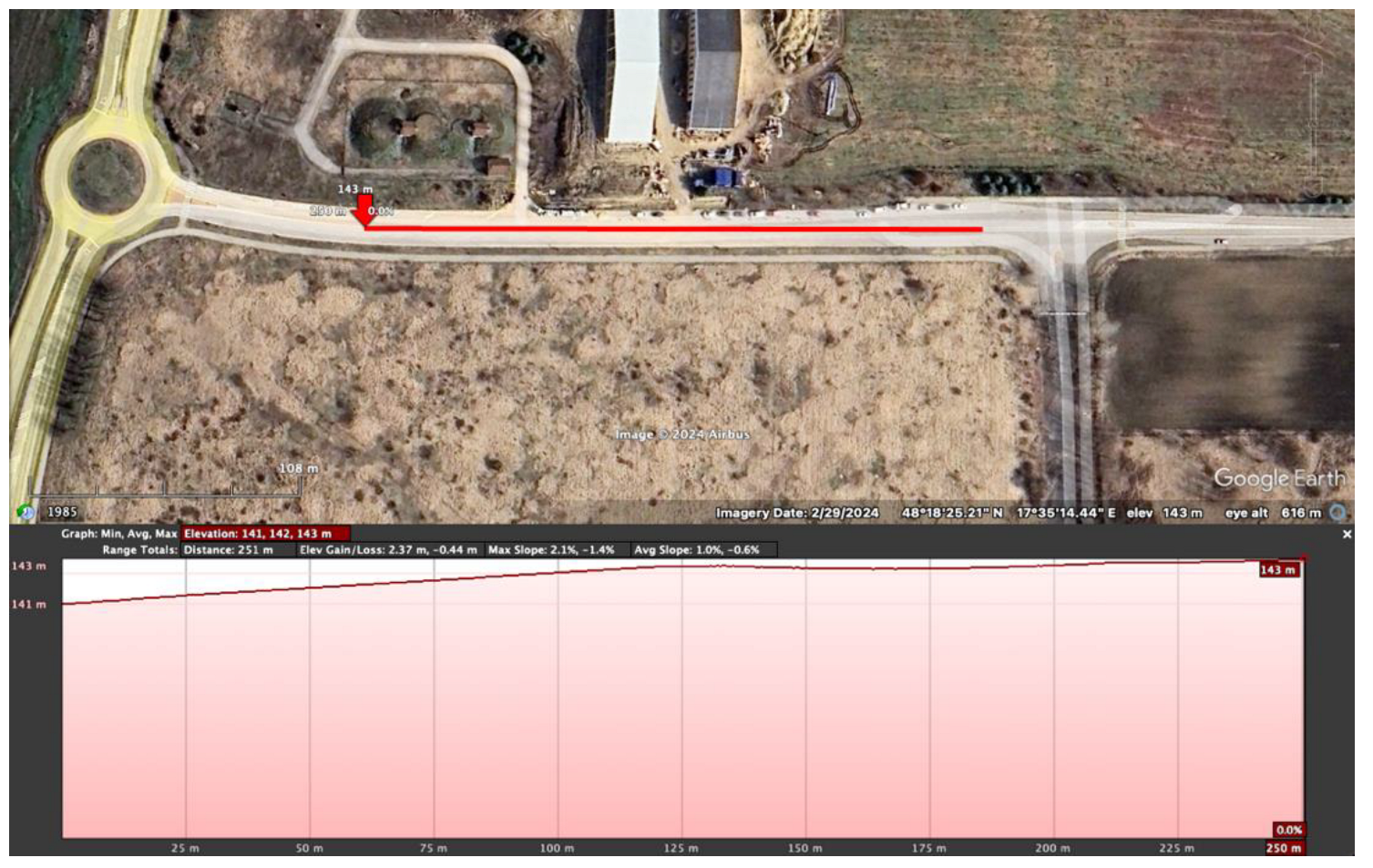
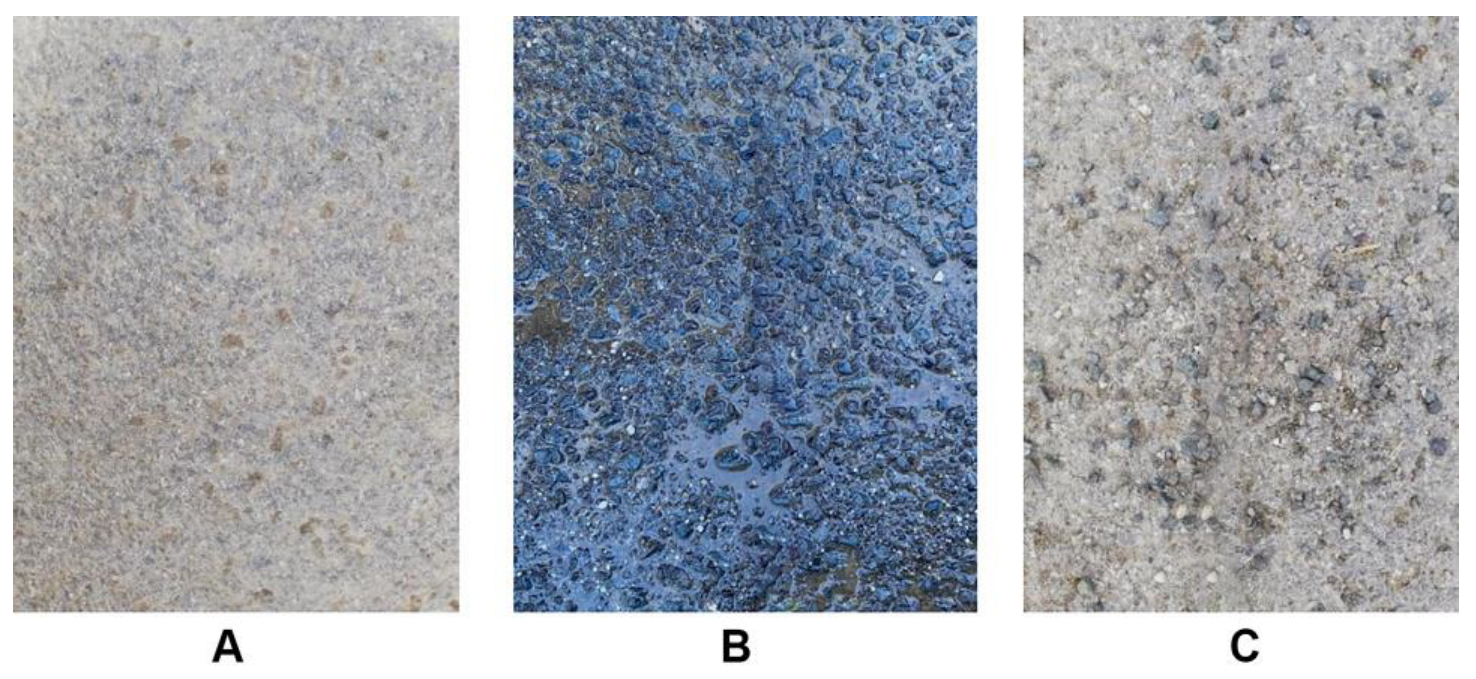
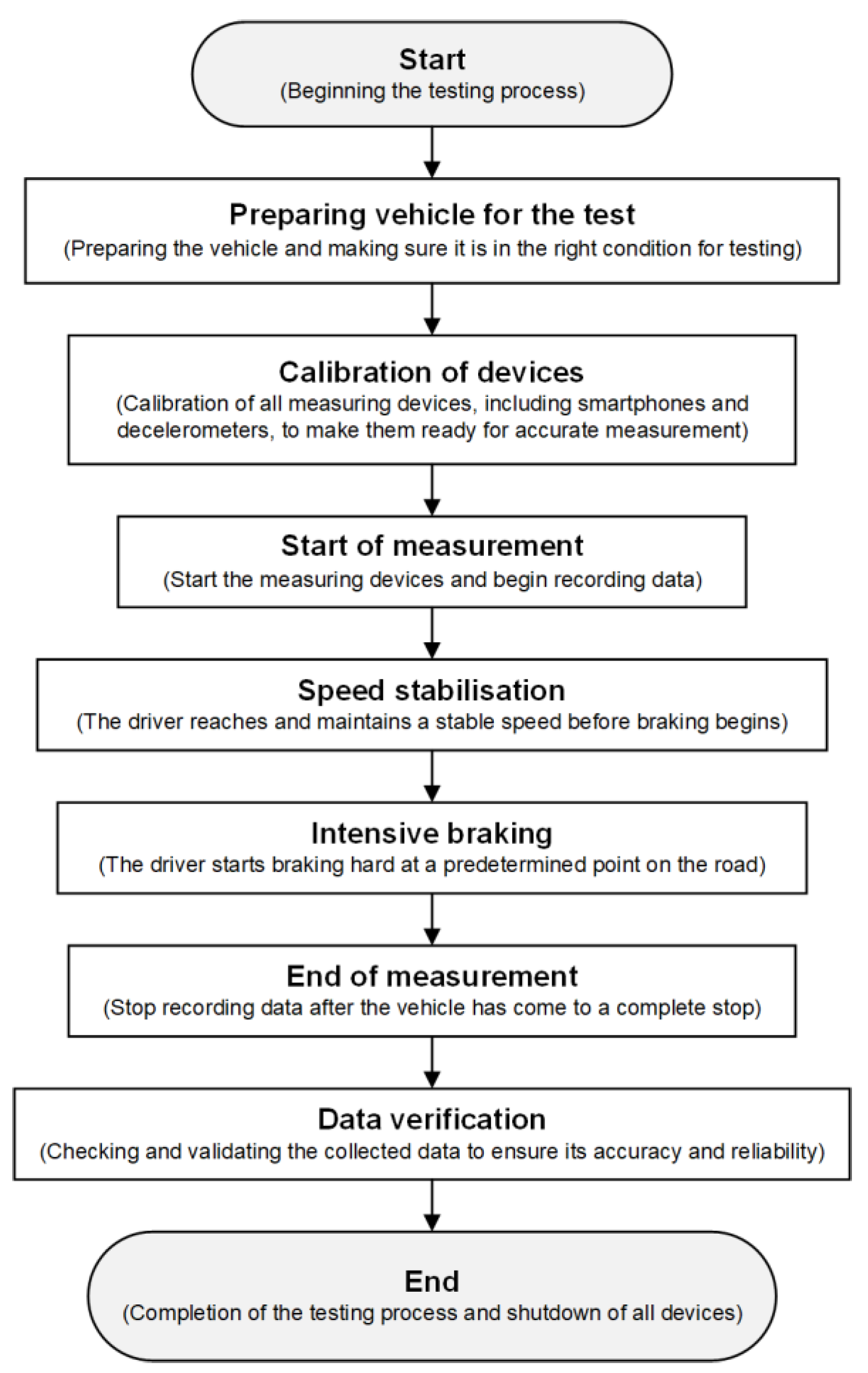
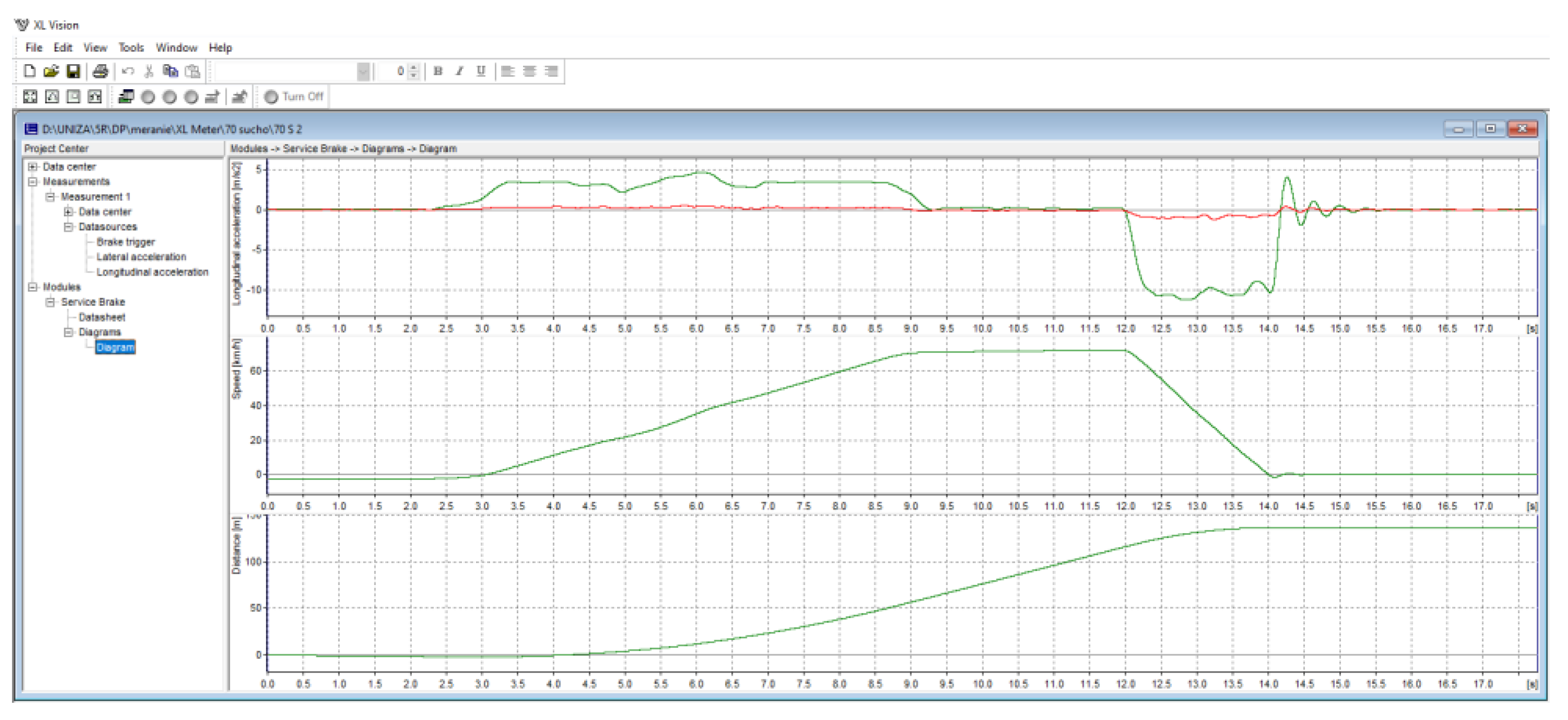
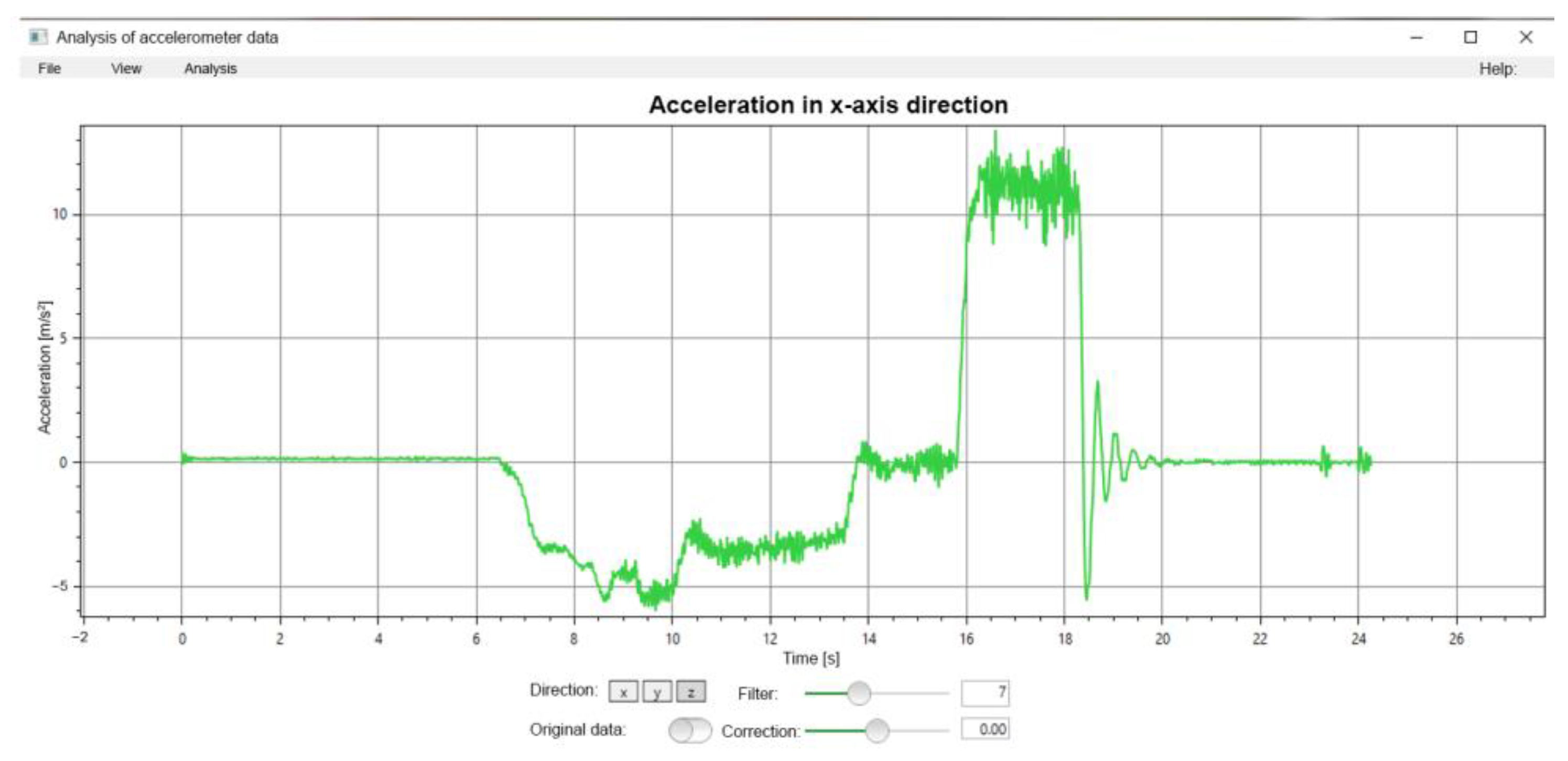

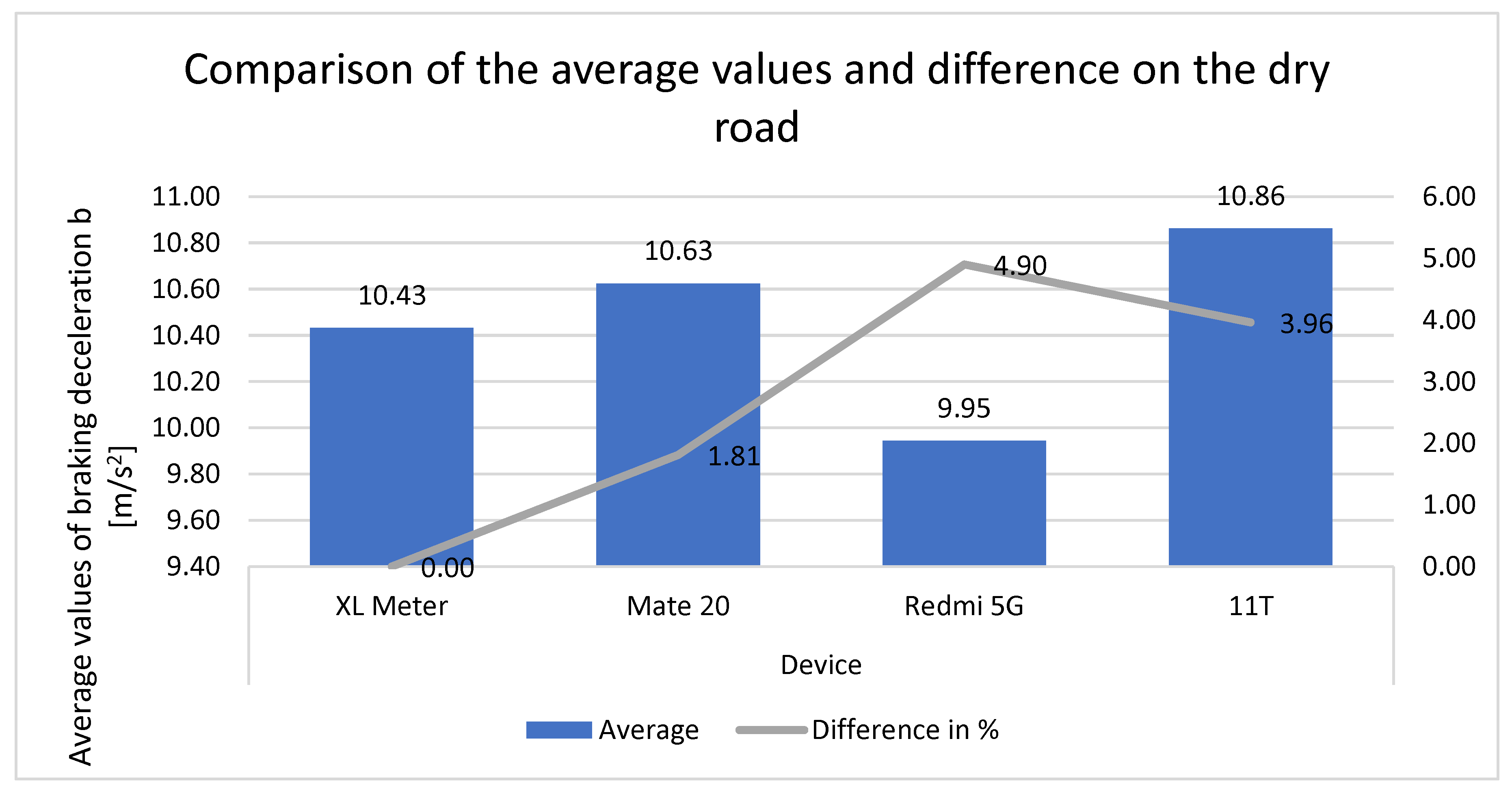
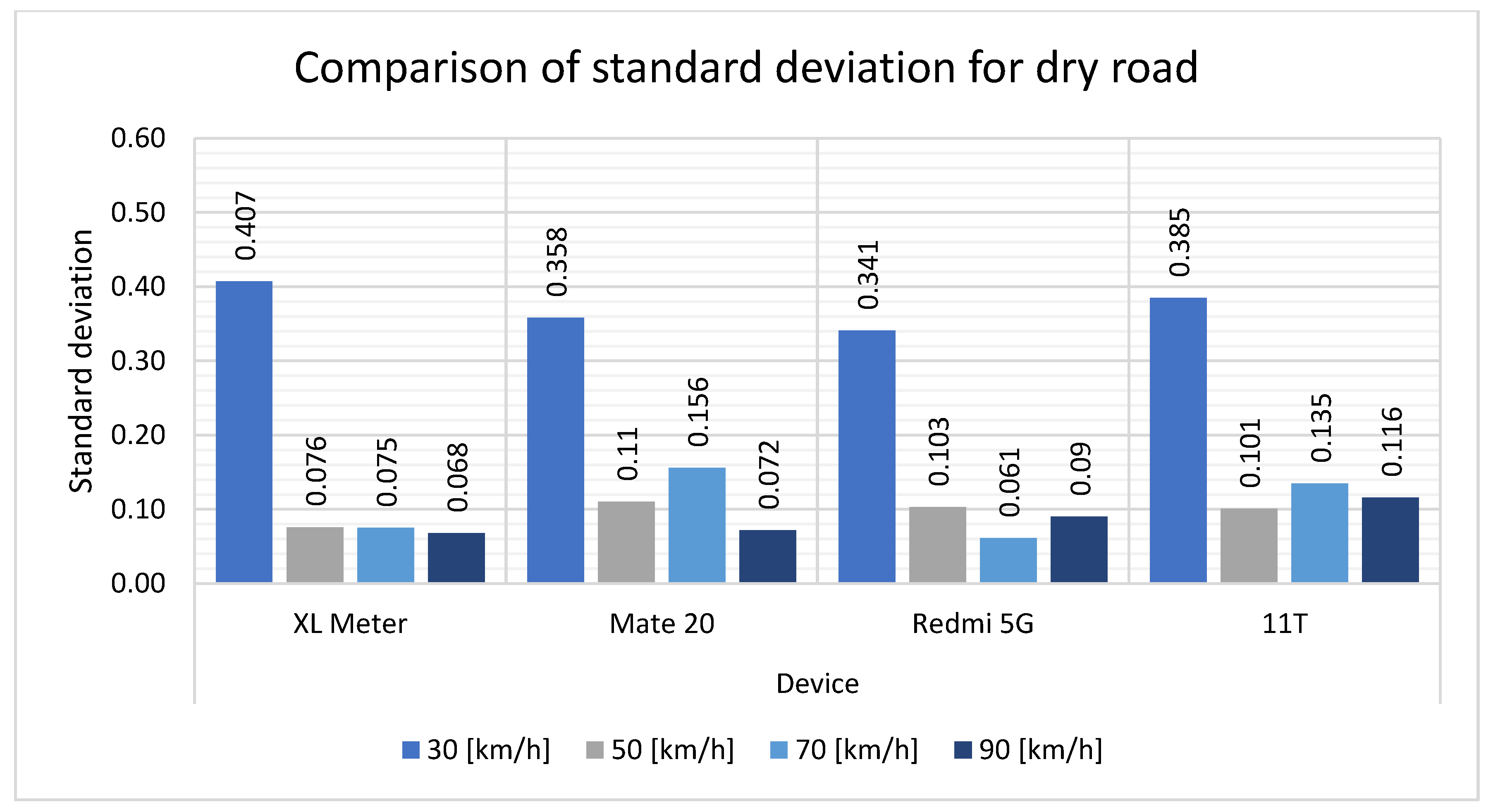

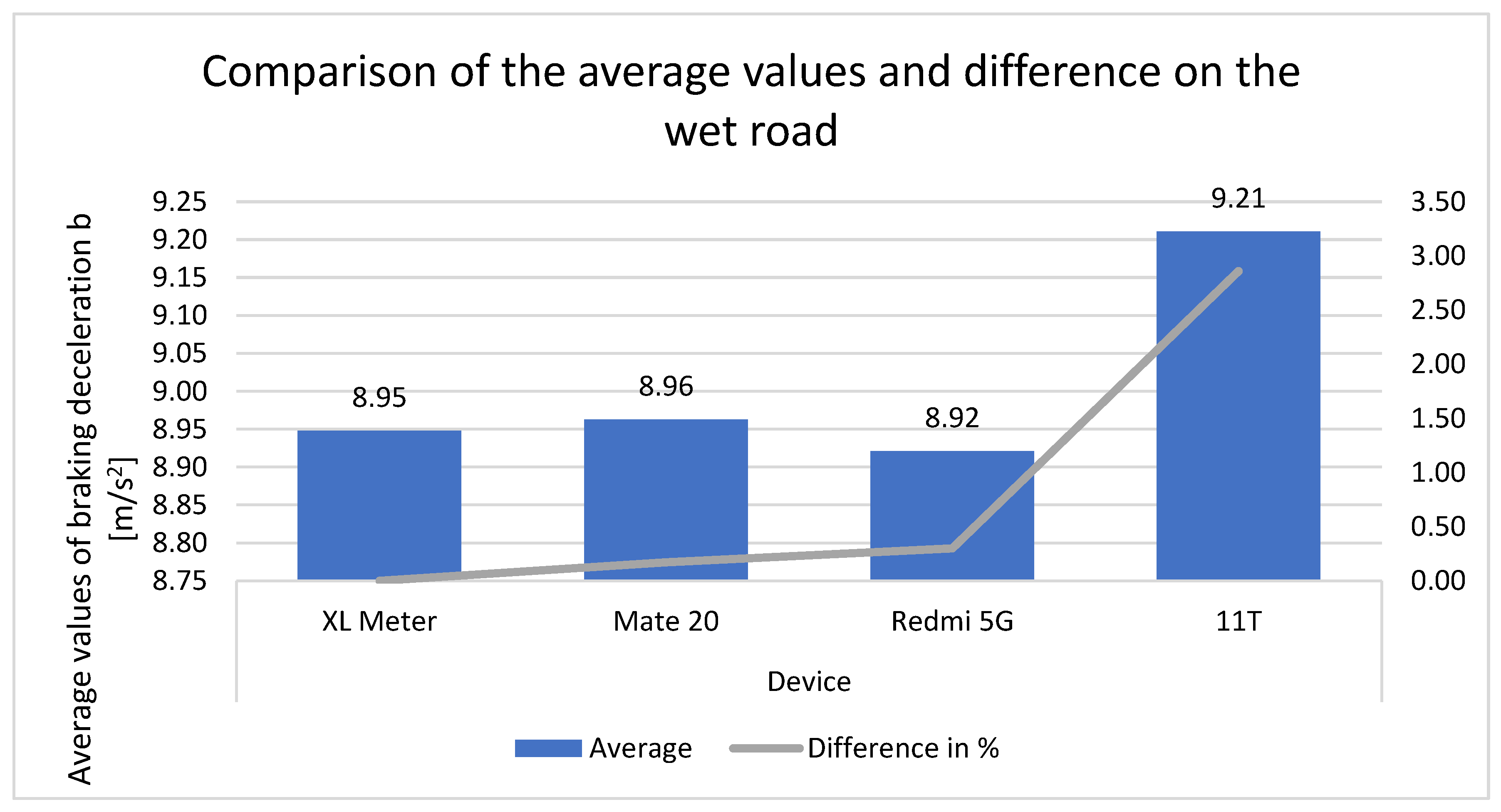

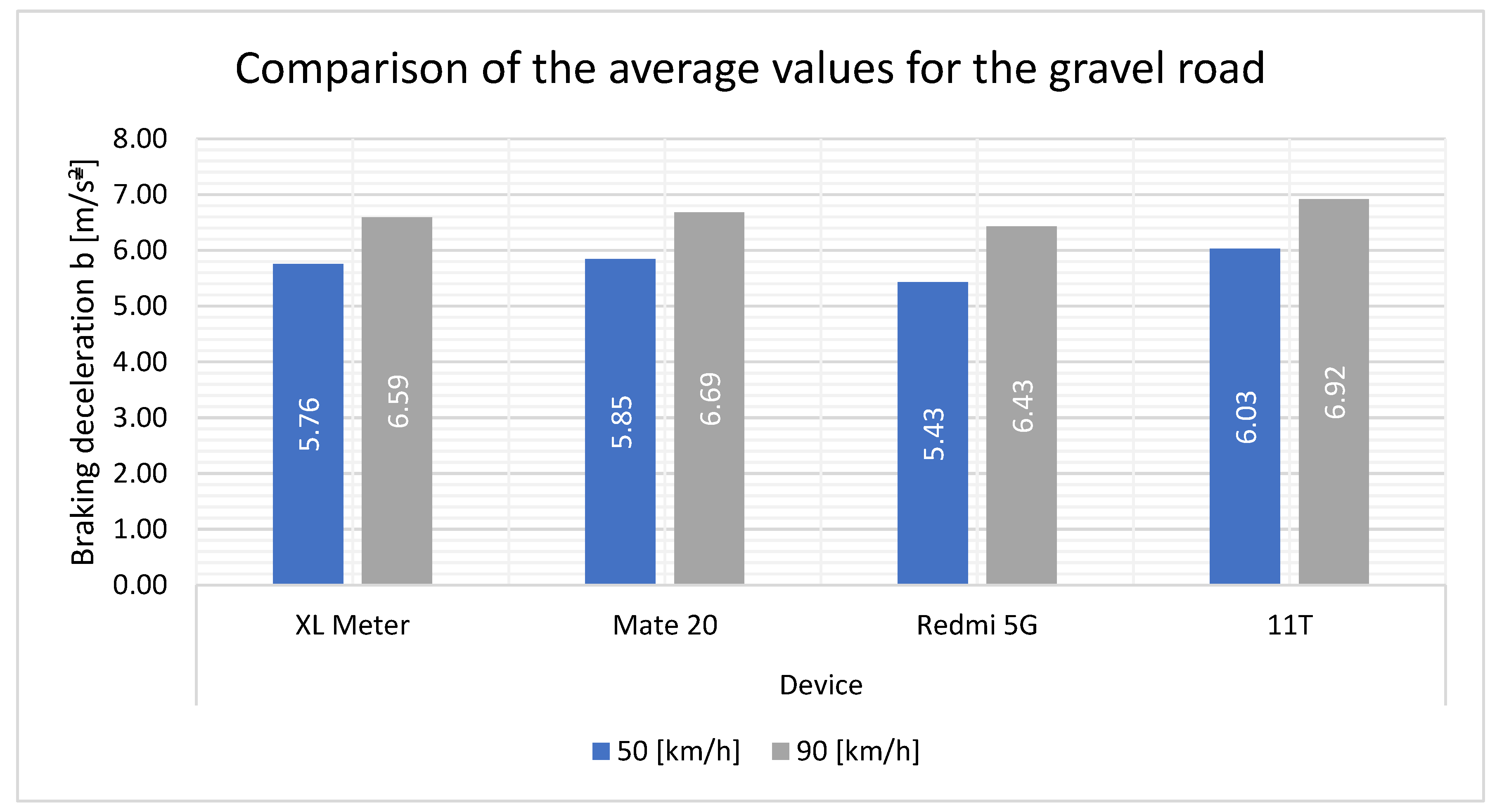
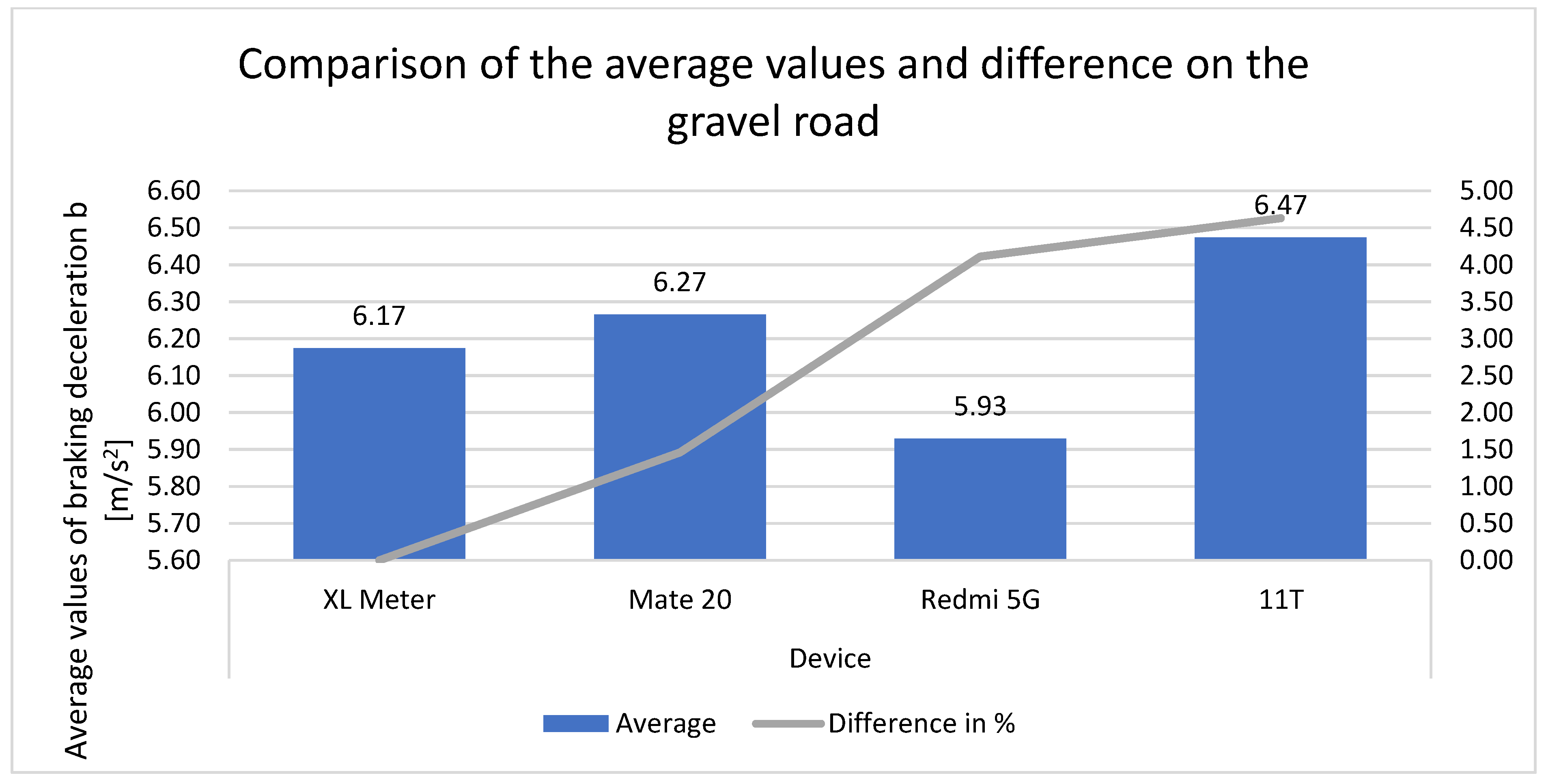
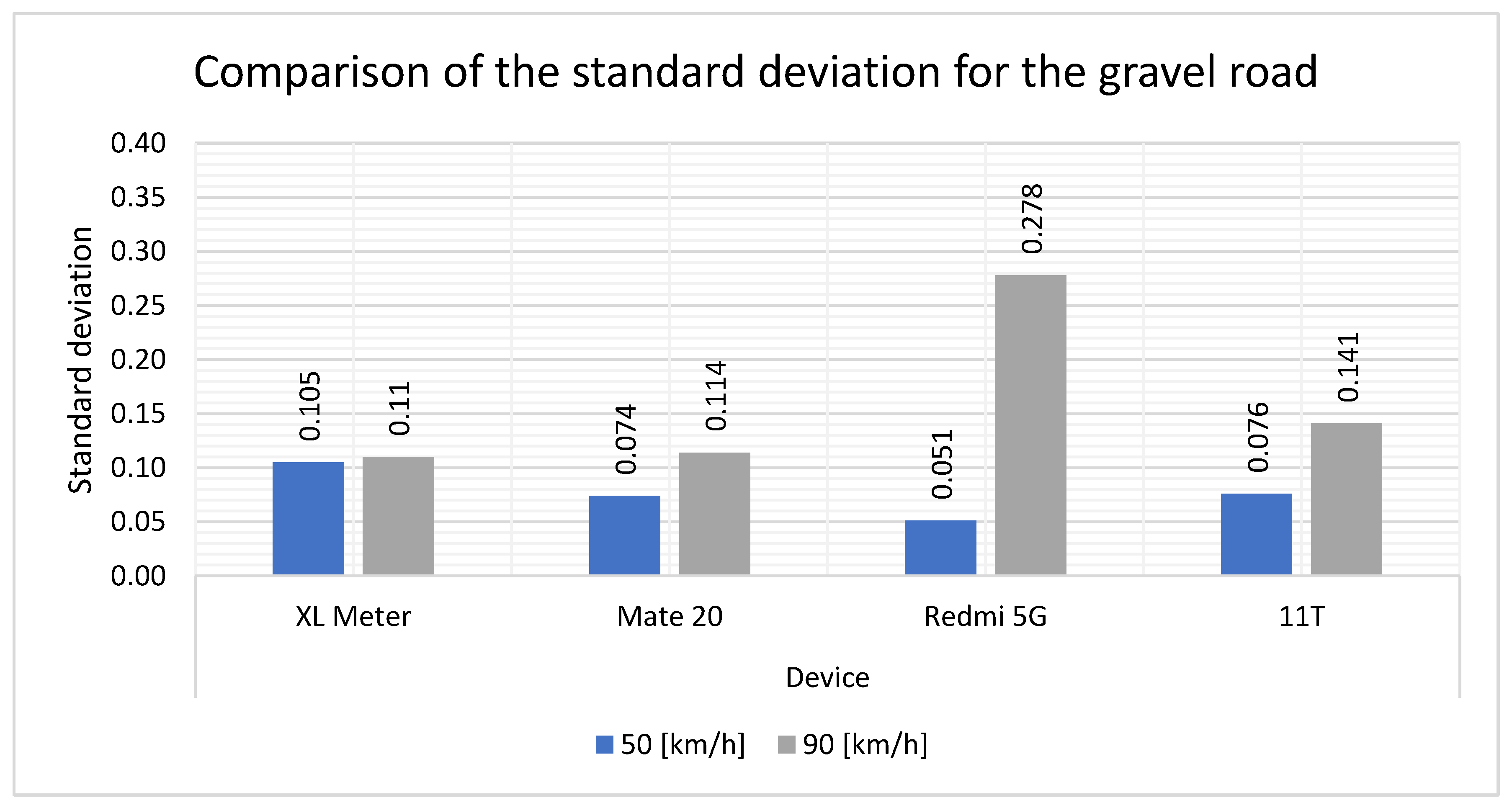

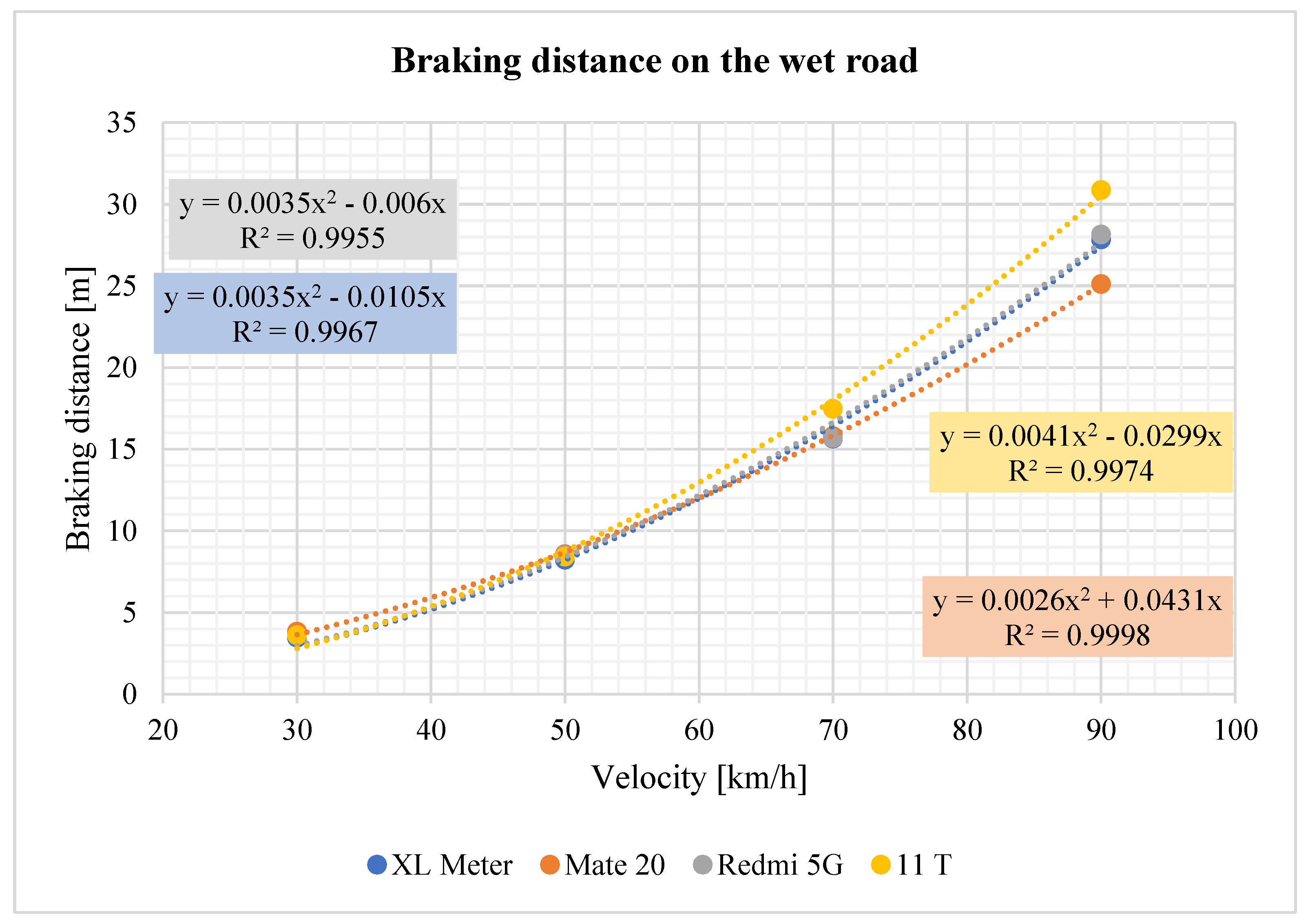

| Parameter | Value |
|---|---|
| Engine | 6-cylinder diesel engine |
| Displacement of engine | 2967 cm3 |
| Power | 202 kW at 3500 rpm |
| Torque | 580 Nm at 1250 rpm |
| Drive wheel | quattro (all-wheel drive) |
| Curb weight | 1895 kg |
| Brakes | Disc 320 mm, thickness 50 mm |
| Number of km driven | 144,701 km |
| Velocity | 30 km/h | 50 km/h | 70 km/h | 90 km/h |
|---|---|---|---|---|
| Temperature of brakes | 49.8 °C | 62.3 °C | 93.2 °C | 162.8 °C |
| XL Meter | Mate 20 | Redmi 5G | 11T | ||||||||
|---|---|---|---|---|---|---|---|---|---|---|---|
| No. | Velocity [km/h] | Time [s] | Distance [m] | b [m/s2] | b ̅ [m/s2] | b [m/s2] | b ̅ [m/s2] | b [m/s2] | b ̅ [m/s2] | b [m/s2] | b ̅ [m/s2] |
| 1 | 26.95 | 0.76 | 2.81 | 9.97 | 10.34 | 10.88 | 10.70 | 10.76 | 10.67 | 11.16 | 10.77 |
| 2 | 25.01 | 0.62 | 2.20 | 10.97 | 10.58 | 10.53 | 10.85 | ||||
| 3 | 24.76 | 0.68 | 2.27 | 10.42 | 10.51 | 10.23 | 10.57 | ||||
| 4 | 25.13 | 0.72 | 2.44 | 9.99 | 10.85 | 11.15 | 10.49 | ||||
| 5 | 44.70 | 1.20 | 7.51 | 10.26 | 10.28 | 10.48 | 10.42 | 10.46 | 10.46 | 10.53 | 10.34 |
| 6 | 44.14 | 1.21 | 7.23 | 10.40 | 10.30 | 10.28 | 10.81 | ||||
| 7 | 44.71 | 1.22 | 7.51 | 10.27 | 10.78 | 10.43 | 10.06 | ||||
| 8 | 45.04 | 1.24 | 7.68 | 10.19 | 10.11 | 10.66 | 9.97 | ||||
| 9 | 60.49 | 1.63 | 13.52 | 10.44 | 10.54 | 10.71 | 10.64 | 10.65 | 10.60 | 10.52 | 10.55 |
| 10 | 65.82 | 1.77 | 15.94 | 10.49 | 10.77 | 10.52 | 10.55 | ||||
| 11 | 63.04 | 1.68 | 14.47 | 10.60 | 10.41 | 10.58 | 10.74 | ||||
| 12 | 63.58 | 1.68 | 14.69 | 10.62 | 10.68 | 10.65 | 10.37 | ||||
| 13 | 79.96 | 2.12 | 23.55 | 10.47 | 10.57 | 10.86 | 10.86 | 10.87 | 10.65 | 10.82 | 10.71 |
| 14 | 79.93 | 2.10 | 23.17 | 10.64 | 10.82 | 10.37 | 10.72 | ||||
| 15 | 80.73 | 2.16 | 23.90 | 10.52 | 11.16 | 10.48 | 11.07 | ||||
| 16 | 82.01 | 2.19 | 24.36 | 10.65 | 10.60 | 10.87 | 10.24 | ||||
| Average | 10.43 | 10.66 | 10.59 | 10.59 | |||||||
| Velocity [km/h] | Device | |||
|---|---|---|---|---|
| XL Meter [m/s2] | Mate 20 [m/s2] | Redmi 5G [m/s2] | 11T [m/s2] | |
| 30 | 10.34 | 10.66 | 10.04 | 10.82 |
| 50 | 10.28 | 10.44 | 9.87 | 10.73 |
| 70 | 10.54 | 10.60 | 9.97 | 10.89 |
| 90 | 10.57 | 10.80 | 9.90 | 11.01 |
| Average | 10.43 | 10.63 | 9.95 | 10.86 |
| Difference | - | 0.19 | 0.49 | 0.43 |
| Difference in % | - | 1.81 | 4.90 | 3.96 |
| Velocity [km/h] | Device | |||
|---|---|---|---|---|
| XL Meter | Mate 20 | Redmi 5G | 11T | |
| 30 | 0.407 | 0.358 | 0.341 | 0.385 |
| 50 | 0.076 | 0.110 | 0.103 | 0.101 |
| 70 | 0.075 | 0.156 | 0.061 | 0.135 |
| 90 | 0.068 | 0.072 | 0.090 | 0.116 |
| Average | 0.157 | 0.174 | 0.184 | 0.149 |
| Difference | - | 0.017 | 0.027 | 0.008 |
| Difference in % | - | 9.770 | 14.670 | 5.370 |
| Velocity [km/h] | Device | |||
|---|---|---|---|---|
| XL Meter [m/s2] | Mate 20 [m/s2] | Redmi 5G [m/s2] | 11T [m/s2] | |
| 30 | 8.16 | 8.18 | 8.46 | 8.22 |
| 50 | 8.24 | 8.19 | 8.16 | 8.31 |
| 70 | 9.91 | 9.94 | 9.72 | 10.40 |
| 90 | 9.49 | 9.55 | 9.35 | 9.92 |
| Average | 8.95 | 8.96 | 8.92 | 9.21 |
| Difference | - | 0.02 | 0.03 | 0.26 |
| Difference in % | - | 0.17 | 0.30 | 2.86 |
| Velocity [km/h] | Device | |||
|---|---|---|---|---|
| XL Meter | Mate 20 | Redmi 5G | 11T | |
| 30 | 0.201 | 0.588 | 0.798 | 0.550 |
| 50 | 0.170 | 0.148 | 0.220 | 0.146 |
| 70 | 0.178 | 0.280 | 0.223 | 0.265 |
| 90 | 0.205 | 0.250 | 0.240 | 0.277 |
| Average | 0.189 | 0.317 | 0.310 | 0.370 |
| Difference | - | 0.129 | 0.121 | 0.182 |
| Difference in % | - | 40.540 | 39.100 | 49.050 |
| Velocity [km/h] | Device | |||
|---|---|---|---|---|
| XL Meter [m/s2] | Mate 20 [m/s2] | Redmi 5G [m/s2] | 11T [m/s2] | |
| 50 | 5.76 | 5.85 | 5.43 | 6.03 |
| 90 | 6.59 | 6.69 | 6.43 | 6.92 |
| Average | 6.17 | 6.27 | 5.93 | 6.47 |
| Difference | - | 0.09 | 0.24 | 0.30 |
| Difference in % | - | 1.46 | 4.11 | 4.63 |
| Velocity [km/h] | Device | |||
|---|---|---|---|---|
| XL Meter [m/s2] | Mate 20 [m/s2] | Redmi 5G [m/s2] | 11T [m/s2] | |
| 50 | 0.105 | 0.074 | 0.051 | 0.076 |
| 90 | 0.110 | 0.114 | 0.278 | 0.141 |
| Average | 0.108 | 0.094 | 0.165 | 0.109 |
| Difference | - | 0.014 | 0.057 | 0.001 |
| Difference in % | - | 14.890 | 34.550 | 0.920 |
| Velocity [km/h] | Device | |||
|---|---|---|---|---|
| XL Meter [m] | Mate 20 [m] | Redmi 5G [m] | 11 T [m] | |
| 30 | 2.43 | 3.06 | 2.74 | 2.92 |
| 50 | 7.48 | 8.35 | 8.07 | 9.21 |
| 70 | 14.66 | 15.34 | 14.73 | 16.58 |
| 90 | 23.75 | 26.08 | 23.35 | 26.69 |
| Velocity [km/h] | Device | |||
|---|---|---|---|---|
| XL Meter [m] | Mate 20 [m] | Redmi 5G [m] | 11 T [m] | |
| 30 | 3.46 | 3.82 | 3.61 | 3.59 |
| 50 | 8.23 | 8.57 | 8.49 | 8.41 |
| 70 | 15.65 | 15.79 | 15.68 | 17.47 |
| 90 | 27.85 | 25.11 | 28.15 | 30.86 |
| Velocity [km/h] | Device | |||
|---|---|---|---|---|
| XL Meter [m] | Mate 20 [m] | Redmi 5G [m] | 11 T [m] | |
| 30 | 15.62 | 16.43 | 15.75 | 17.03 |
| 50 | 43.98 | 45.48 | 41.17 | 47.67 |
Disclaimer/Publisher’s Note: The statements, opinions and data contained in all publications are solely those of the individual author(s) and contributor(s) and not of MDPI and/or the editor(s). MDPI and/or the editor(s) disclaim responsibility for any injury to people or property resulting from any ideas, methods, instructions or products referred to in the content. |
© 2024 by the authors. Licensee MDPI, Basel, Switzerland. This article is an open access article distributed under the terms and conditions of the Creative Commons Attribution (CC BY) license (https://creativecommons.org/licenses/by/4.0/).
Share and Cite
Ondruš, J.; Jančár, A.; Gogola, M.; Varga, P.; Šarić, Ž.; Caban, J. Smartphone Sensors in Motion: Advancing Traffic Safety with Mobile Technology. Appl. Sci. 2024, 14, 5404. https://doi.org/10.3390/app14135404
Ondruš J, Jančár A, Gogola M, Varga P, Šarić Ž, Caban J. Smartphone Sensors in Motion: Advancing Traffic Safety with Mobile Technology. Applied Sciences. 2024; 14(13):5404. https://doi.org/10.3390/app14135404
Chicago/Turabian StyleOndruš, Ján, Arnold Jančár, Marián Gogola, Peter Varga, Željko Šarić, and Jacek Caban. 2024. "Smartphone Sensors in Motion: Advancing Traffic Safety with Mobile Technology" Applied Sciences 14, no. 13: 5404. https://doi.org/10.3390/app14135404
APA StyleOndruš, J., Jančár, A., Gogola, M., Varga, P., Šarić, Ž., & Caban, J. (2024). Smartphone Sensors in Motion: Advancing Traffic Safety with Mobile Technology. Applied Sciences, 14(13), 5404. https://doi.org/10.3390/app14135404







